Impression, Sunrise by Claude Monet - A Closer Look and Analysis
In this post I accept a closer look at one of my favorite paintings,Impression, Sunrise by Claude Monet - the painting which gave Impressionism its proper noun.
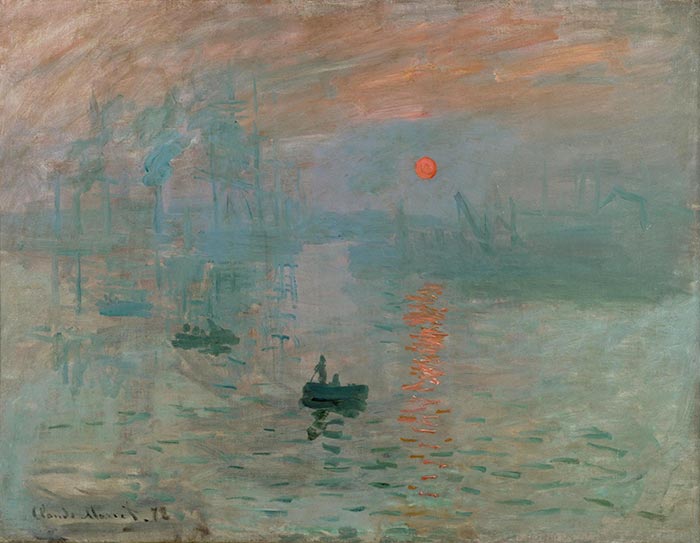
Claude Monet, Impression, Sunrise, 1872
Central Facts About Impression, Sunrise
- Impression, Sunrise was painted in 1872, when Monet was 32.
- It depicts the port of Le Havre in French republic, where Monet grew up. It is one of a serial of paintings based on Le Havre painted around the same time. Beneath are two of the other paintings in the series:
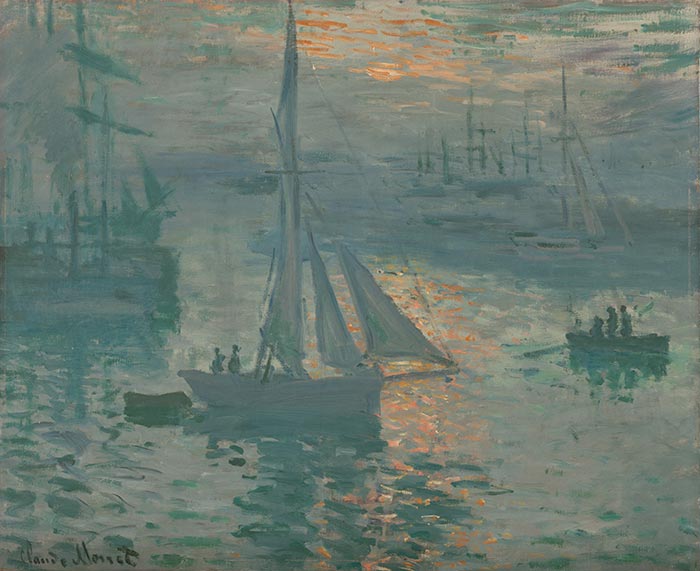
Claude Monet, Sunrise, Marine, 1873
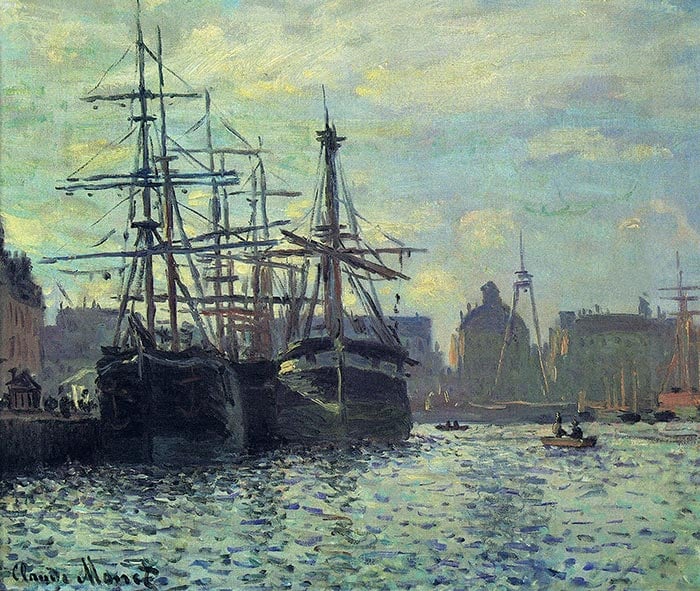
Claude Monet, Le Bassin Du Commerce, Le Havre, 1874
- The series was exhibited in 1874 at the "Exhibition of the Impressionists". Some of the other artists who exhibited alongside Monet were Camille Pissarro, Alfred Sisley, Paul Cézanne, Berthe Morisot and Edgar Degas.
- Fine art critic Louis Leroy wrote about the exhibition in the newspaper Le Charivari and used the term "Impressionism" to mock the loose and relaxed nature of the paintings. Only, despite the intended criticism, the artists adopted the term equally the name of the move, Impressionism. Here is an extract from Leroy'due south article, which takes the perspective of two skeptical viewers discussing Monet's painting:
"Impression I was sure of information technology. I was just telling myself that, since I was impressed, there had to be some impression in it — and what freedom, what ease of workmanship! A preliminary cartoon for a wallpaper pattern is more finished than this seascape."
- Monet named the painting based on his loose depiction of the port. He explained:
"They asked me for a title for the catalogue, it couldn't really be taken for a view of Le Havre, and I said: 'Put Impression.'"
Color and Light
The focus of this painting is almost entirely on color and light. The brushwork is loose, the detail is elementary and the composition is fairly basic. Only the use of colour to depict light is enough to brand this painting work.
Most of the painting is made upwardly of dull oranges, blues and greens, which form the backdrop for the dark green boats and the vivid orangish sunrise.
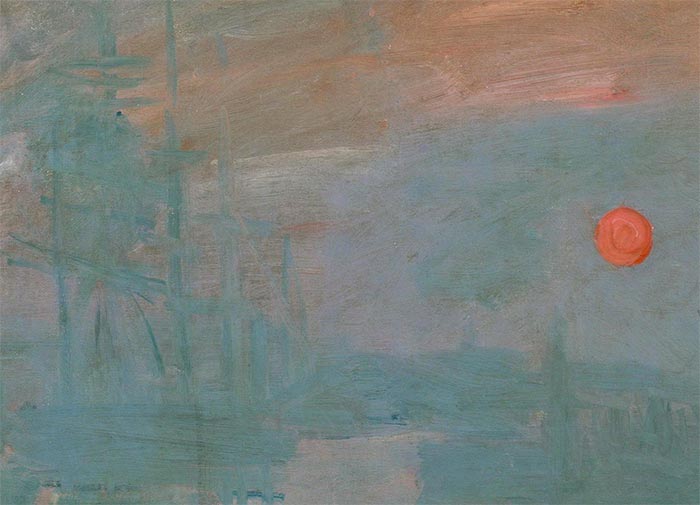

In my opinion, the nearly interesting part of the painting is the use of vivid orangish to paint light. The sun and its reflection actually leap out from the rest of the dull tones. Before you lot keep reading, have a think near how light or dark the orange sunrise and its reflection are compared to the surrounding colors.
The answer is they are almost the exact aforementioned value, as revealed past the grayscale prototype beneath. At that place is basically no value dissimilarity, only saturation and hue dissimilarity. The dark boat, on the other hand, represents a strong value dissimilarity from the surrounding colors.
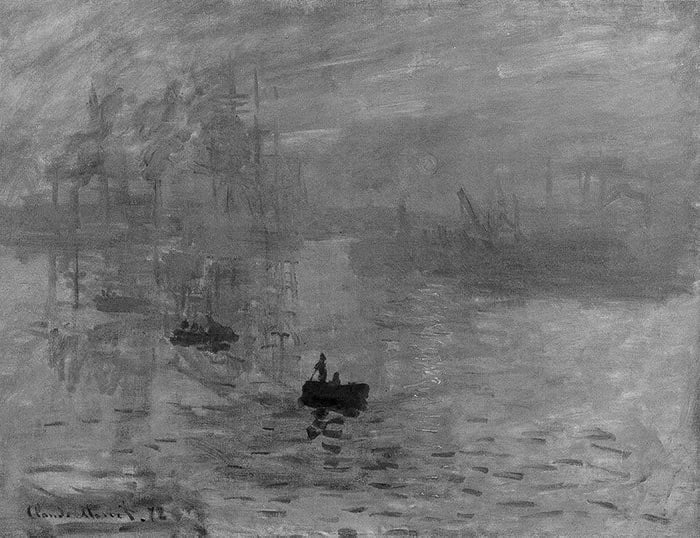
Whenever nosotros are painting an actual light source (like the sun, a lamp or street lite), a dilemma we face as artists is that our paints are not able to hitting the same intensity of light itself. The other dilemma, especially for painting awarm light source like the sun, is that our colors tend to go weaker and cooler with the addition of white. What Monet shows with this painting is just how powerful saturation dissimilarity tin can exist, specially for painting a warm light source.
(Y'all might likewise exist interested in my Painting Academy form. It will aid you empathize and use color more effectively in painting.)
Brushwork
The brushwork is loose and fluent, as if Monet painted this without hesitation. In that location is a dissimilarity between the thin paint used for the background and the thick, impasto pigment used for bold accents (the boats, the sun and its reflection).
Below is a close-up of the sky. To me, it looks like a build up of thin washes, with some vague details painted on pinnacle using (I assume) a wet on moisture technique.
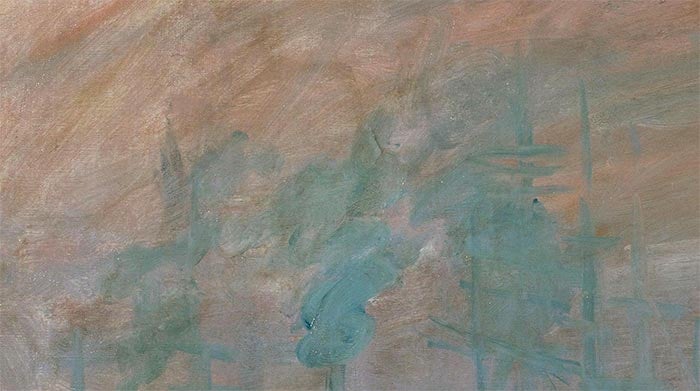
The dark green boat seems to take been painted with only a few bold strokes with a relatively large castor (yous can run across the individual brush marks in the close-upward below). More than aggressive brushwork was used for the sunrise reflection.
Also, notice how sunrise reflection was non painted with a solid orange color. There are touches of unmixed white and various orange tones in there. This gives each stroke an interesting broken color consequence.

Monet used a similar technique at the bottom of the painting with the dashes of nighttime green. This suggests movement in the h2o and adds to the depth in the painting as they are but present in the foreground.
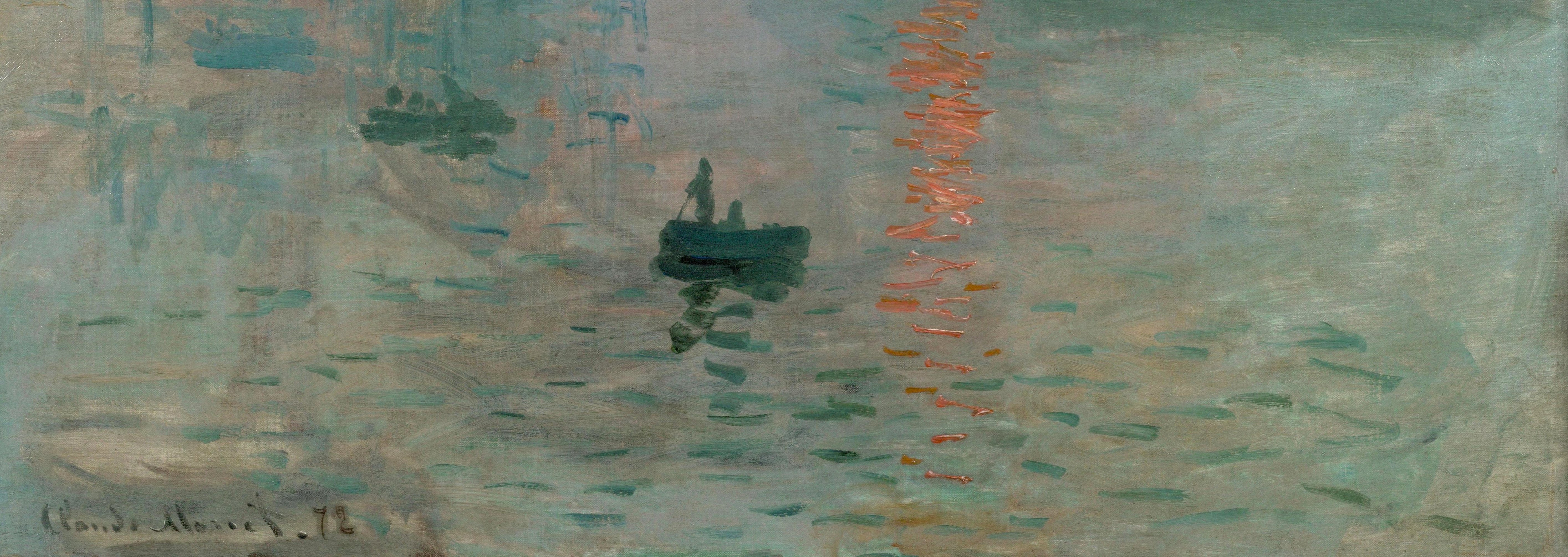
The brushwork in the sky follows a downwardly curve which gives the painting a sense of motility and keeps your attention inside the painting. Had Monet painted the heaven with bang-up, horizontal brushwork, information technology would await much more static.
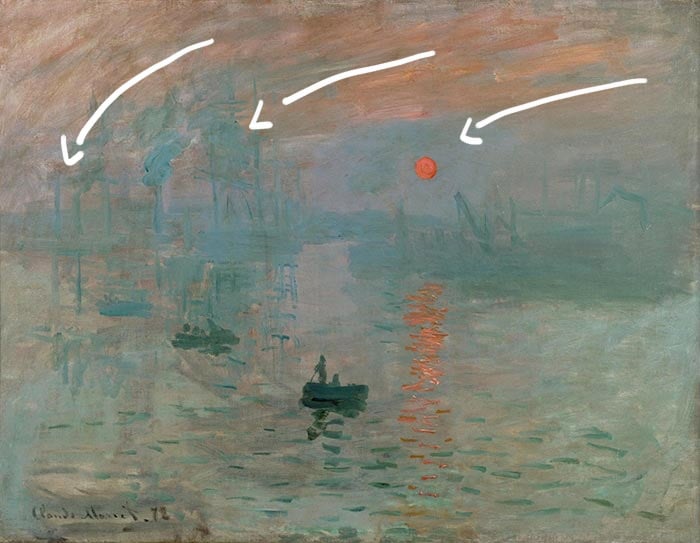
Composition
The limerick is fairly basic, but at that place are some important aspects:
- The focal points are conspicuously the night boats, the sunrise and its reflection. Everything else is actually just at that place to create a sense of context and temper.
- The focal points are positioned off-center around the middle.
- There is an interesting disharmonism betwixt low-cal and dark where the sunrise reflection meets the dark green shadows. The sunrise reflection represents a strong verticle line in the painting, despite it being made upwardly of short, horizontal dashes. The night greenish shadows in the foreground are spaced out and as a whole, stand for a loose horizontal line.
- The horizon line barely exists. In that location are simply some buildings and faded bluish shapes in the distance which suggest where land meets the sky.
- The horizon line is positioned slightly above heart. Many artists avoid placing the horizon line directly in the middle as information technology tends to appear unnatural.
- Depth is created by the gradual fading of objects every bit they recede into the distance. Too, the relatively absurd colors used around the horizon line push that area back in perspective, whilst the warm colors used for the pinnacle of the sky come forward.

Key Takeaways from Impression, Sunrise
- Value (how light or dark a color is) is often taught as beingness the most important element of a color. But this painting by Monet demonstrates simply how powerful saturation dissimilarity can exist (only wait at the contrast betwixt the orangish dominicus and the dull, surrounding colors).
- If you want to draw attention to a particular surface area in your painting, then simplify the surrounding areas. In this painting, Monet draws your attention towards the vibrant oranges and dark greens, which stand up out from the deadening and simplified background.
- Your initialimpression of a subject is a powerful thing. Learn to capture it by painting with instinct. I ever try to outset my paintings with loose brushwork to capture my first impression of the subject. I and so refine from there if necessary.
Learn More
Cheers for Reading!
Thanks for taking the time to read this post. I appreciate information technology! Feel gratis to share with friends. If y'all want more than painting tips, check out my Painting University course.
Happy painting!

Dan Scott
Draw Paint Academy
Source: https://drawpaintacademy.com/impression-sunrise/
0 Response to "Impression, Sunrise by Claude Monet - A Closer Look and Analysis"
Post a Comment